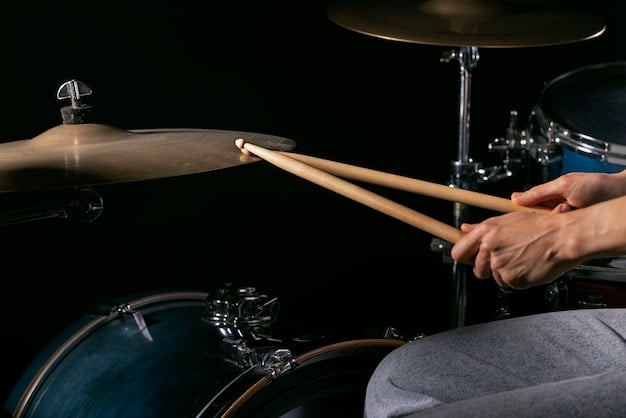Groove Metal Rhythms: Syncopation for Headbanging Power

Groove metal rhythms leverage syncopation, a deliberate disruption of expected beats, to create a powerful, headbanging experience, setting it apart from other metal subgenres through its emphasis on rhythmic complexity and catchiness.
Groove metal rhythms: achieving headbanging power with syncopation are the lifeblood of a subgenre known for its infectious grooves and mosh-inducing energy. By exploring the concept of syncopation, we’ll uncover the secrets behind groove metal’s rhythmic complexity and its ability to get heads banging worldwide.
Understanding Groove Metal: A Rhythmic Overview
Let’s delve into the basics of groove metal. It’s essential to understand what sets this subgenre apart when it comes to rhythmic structures.
Groove metal distinguishes itself through its emphasis on rhythm, prioritizing a “groove” that’s both catchy and powerful. This rhythm-centric approach makes it instantly recognizable and danceable, even within the broader spectrum of metal.
Key Characteristics of Groove Metal Rhythms
Groove metal’s rhythmic foundation relies on a few core elements that contribute to its distinctive sound. Let’s take a look at some of them:
- Emphasis on the Mid-Tempo: Groove metal typically avoids the extreme speeds of thrash or death metal, favoring a mid-tempo range. This allows for more rhythmic articulation and emphasis on the groove.
- Syncopation: The deliberate placement of accents on unexpected beats, creating a sense of rhythmic displacement and anticipation.
- Use of Palm-Muted Chugs: Provides a percussive, driving foundation to the rhythm, adding weight and impact.
The incorporation of these elements generates a sound that encourages physical movement – the essence of what makes groove metal so appealing to headbangers.

Defining Syncopation: The Heart of Groove
Syncopation is crucial to understanding groove metal’s distinct sound. It’s more than just playing off-beat; it’s a calculated manipulation of rhythm.
Specifically, syncopation involves accenting beats that are normally unaccented, or de-emphasizing beats that are typically strong. This creates a sense of rhythmic tension and release, drawing listeners in and making them want to move.
How Syncopation Works in Music
Syncopation works by disrupting our expectations of where the beat should fall. Here’s how it achieves this:
- Off-Beat Accents: Instead of emphasizing beats 1 and 3 in a 4/4 time signature, syncopation might accent beats 2 and 4, or even the “ands” between the beats.
- Tied Notes: Connecting a weak beat to a strong beat can create syncopation by prolonging the emphasis on the unexpected beat.
- Rhythmic Displacement: Slightly shifting the placement of a rhythmic phrase can create a syncopated feel, making the listener anticipate the resolution.
By strategically violating conventional rhythmic patterns, syncopation generates a driving, propulsive energy that’s fundamental to the groove metal experience.
Iconic Examples of Syncopated Rhythms in Groove Metal
Many bands have harnessed the power of syncopation to create some of the most iconic and headbanging-worthy tracks in groove metal. Let’s examine a few examples.
Looking at some specific songs will help clarify how syncopation is actually used in practice and what contributes to that trademark “groove.”

Pantera – “Walk”
“Walk” is a masterclass in simple yet effective syncopation. The main riff is based around a heavily palm-muted, syncopated rhythm that emphasizes the off-beats. This creates a sense of unease and tension that perfectly complements the song’s aggressive lyrics.
Lamb of God – “Redneck”
“Redneck” features a complex interplay of syncopated rhythms between the guitars and drums. The guitar riffs often accent the off-beats, while the drums provide a driving, syncopated foundation. This creates a chaotic yet incredibly groovy sound.
Machine Head – “Davidian”
“Davidian” is known for its aggressive and powerful groove. The syncopation in this song is used to create a sense of urgency and aggression. The off-beat accents and rhythmic displacement contribute to the song’s chaotic and intense feel.
These examples showcase the versatility of syncopation in groove metal and how it is used to create different moods and textures.
The Role of Drums in Delivering Syncopated Groove
The drummer is essential in establishing the groove and accentuating syncopated rhythms. Understanding the drummer’s role offers more insight into the overall sound.
The drums often lay the groundwork for the syncopated feel, complementing the guitar riffs or creating rhythmic counterpoints that enhance the sense of groove.”
Drumming Techniques for Syncopation
- Ghost Notes: Very quiet notes played on the snare drum, often on off-beats, to add subtle rhythmic complexity.
- Open Hi-Hat Accents: Opening the hi-hat on unexpected beats can create a splashy, syncopated accent.
- Creative Cymbal Work: Using different cymbals for accents and fills can also add rhythmic interest and syncopation.
Drummers use these techniques, combined with their creative instincts, to elevate the groove and push the boundaries of the rhythm.
Other Instruments and Their Contribution
While drums often anchor the syncopated groove, other instruments also play a significant role in crafting that irresistible sound.
The guitar, bass, and even vocals can contribute to the syncopated feel, working in concert to create a powerful and engaging rhythmic experience.
Guitar Techniques for Syncopation
- Rhythmic Chords: Playing chords on the off-beats or using staccato rhythms can add syncopation to the guitar part.
- Single-Note Riffs: Crafting single-note riffs that emphasize the off-beats or use rhythmic displacement.
- Palm-Muting: Palm-muting on syncopated rhythms can create a percussive and driving feel.
These techniques, when combined with the drums and bass, create a cohesive and powerful rhythmic foundation for groove metal.
Creating Your Own Syncopated Groove Metal Rhythms
Now we come to the practical application. How can musicians create syncopated groove metal rhythms themselves?
Experimentation is key. By understanding the principles of syncopation and practicing different techniques, musicians can develop their own unique groove metal styles.
Tips for Writing Groove Metal Rhythms
- Start with a Simple Beat: Don’t try to make it too complex from the beginning. Start with a basic beat and gradually add syncopation.
- Experiment with Different Accents: Try accenting different beats or subdivisions of the beat to see what sounds best.
- Listen to Your Favorite Groove Metal Bands: Pay attention to how they use syncopation in their music. Imitate their techniques, and add your own twist.
Creating innovative rhythms is essential for driving the genre forward and discovering new sonic territories.
| Key Point | Brief Description |
|---|---|
| 🎶 Syncopation | Deliberate disruption of expected beats. |
| 🥁 Drumming | Essential for establishing the groove. |
| 🎸 Guitars | Utilize rhythmic chords and riffs. |
| 🤘 Headbanging | The ultimate response to groove metal rhythms. |
Frequently Asked Questions (FAQ)
▼
Groove metal emphasizes rhythm and often features syncopated beats. The focus is on creating a “groove” that makes you want to move, differentiating it from faster, more chaotic metal subgenres.
▼
Syncopation creates rhythmic tension and unexpected accents, making the music more engaging and exciting. This rhythmic complexity encourages a physical response, such as headbanging, which helps release the tension.
▼
Pantera, Lamb of God, and Machine Head are known for using syncopation in their music. These bands incorporate syncopated rhythms into their riffs and drum patterns to create their signature sound.
▼
Drumming techniques like ghost notes, open hi-hat accents, and creative cymbal work can enhance syncopation. These techniques add subtle rhythmic complexities that contribute to the overall groove.
▼
Guitarists can create syncopated rhythms by playing chords on off-beats, using staccato rhythms, and crafting single-note riffs that emphasize unexpected beats. Palm-muting can also add a percussive feel to syncopated rhythms.
Conclusion
Syncopation is the cornerstone of what makes groove metal so captivating and physically engaging. By understanding and experimenting with syncopated rhythms, both musicians and listeners can appreciate the intricacy and power of this dynamic subgenre.





